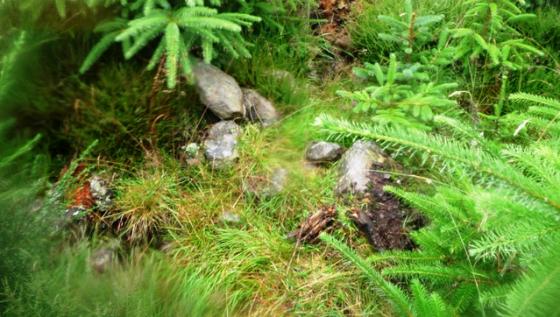From p41 of ‘Scenes and Legends of the North of Scotland, Or The Traditional History of Cromarty’ by Hugh Miller [1835].
Towards [the] eastern boundary [of the moor], and about six miles from the town of Cromarty, there is a huge heap of stones, which from time immemorial has been known to the people of the place as The Grey Cairn, a name equally descriptive of other lesser cairns in its vicinity, but which with the aid of the definitive article serves to distinguish it. [..]
About fifteen years ago a Cromarty fisherman was returning from Inverness by a road which for several miles skirts the upper edge of the moor, and passes within a few yards of the cairn. Night overtook him ere he had half completed his journey [..] As he approached the cairn, a noise [other than his footsteps, reached his ears, one which] his profession had made him well acquainted, = that of waves breaking against a rock. The nearest shore was fully three miles distant, the nearest cliff more than five, and yet he could hear wave after wave striking as if against a precipice, then dashing upwards, and anon descending, as distinctly as ever hehad done when passing in his boat beneath the promontories of Cromarty. On coming up to the cairn, his astonishment was converted into terror. Instead of the brown heath, with here and there a fir seedling springing out of it, he saw a wide tempestuous sea stretching before him, with the large pile of stones frowning over it, like one of the Hebrides during the gales of the Equinox. The pile appeared half enveloped in cloud and spray, and two large vessels, with all their sheets spread to the wind, were sailing round it.
The writer of these chapters had the good fortune to witness at this cairn a scene which, without owing any thing to the supernatural, almost equalled the one described. He was, like the fisherman, returning from Inverness to Cromarty in a clear frosty night of December. There was no moon, but the whole sky towards the north was glowing with the Aurora Borealis, which, shooting from the horizon to the the central heavens, in flames tinged with all the hues of the rainbow, threw so strong a light, that he could have counted every tree of the wood, and every tumulus of the moor. There is a long hollow morass which runs parallel to the road for nearly a mile; it was covered this evening by a dense fleece of vapour raised by the frost, and which, without ascending, was rolling over the moor before a light breeze. It had reached the cairn, and the detached clump of seedlings which springs up at its base. = The seedlings rising out of the vapour appeared like a fleet of ships, with their sails drooping against their masts, on a sea where there were neither tides nor winds; – the cairn, grey with the moss and lichens of forgotten ages, towered over it like an island of that sea.
How very strange. To be read, with additional flowery language, at Google Books.

































































































